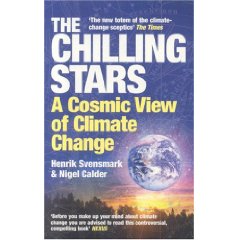 Yesterday, in the post Countdown to Copenhagen, I mentioned that there are still quite a few scientists around the world who agree that climate change exists, but don’t agree about the cause. To kick off my three views in seven days series, is a review of the book, “The Chilling Stars A New Theory of Climate Change.” The authors are climate physicist Henrik Svensmark and award winning science writer Nigel Calder.
Yesterday, in the post Countdown to Copenhagen, I mentioned that there are still quite a few scientists around the world who agree that climate change exists, but don’t agree about the cause. To kick off my three views in seven days series, is a review of the book, “The Chilling Stars A New Theory of Climate Change.” The authors are climate physicist Henrik Svensmark and award winning science writer Nigel Calder.
Let me start off by acknowledging that the majority of scientists believe that greenhouse gas emissions, primarily CO2, are causing global climate change. However, here is what Svensmark and Calder say about carbon dioxide. “To correct apparent over-estimates of the effects of carbon dioxide is not to recommend a careless bonfire of the fossil fuels that produce the gas. A commonplace libel is that anyone skeptical about the impending global-warming disaster is probably in the pay of the oil companies.”
They continue, “In fact, there are compelling reasons to economize in the use of fossil fuels, which have nothing to do with the climate–to minimize unhealthy smog, to conserve the planet’s limited stocks of fuel, and to keep energy prices down for the benefit of the poorer nations.”
So if climate change is not driven in part by CO2, as argued by the authors, then what is the primary driver of climate change?
The premise of Svensmark’s climate change theory is that the interplay between clouds, the sun and cosmic rays, have a greater effect on climate than man-made carbon dioxide. For those who don’t remember much of any science from high school or college a cosmic ray is comprised of sub-atomic particles from exploded stars.
They set up the stage by explaining that clouds are in charge of the climate. “Their variations follow changes in the intensity of the cosmic rays due to stronger or weaker magnetic shielding by the sun, with little regard for anything else that may be happening on the Earth.”
The authors then begin to lay out the scientific foundation that caused them to arrive at this conclusion. “Between 1984 and 1987 the sun gradually became less stormy and more cosmic rays reached the Earth. Cloudiness over the oceans increased progressively by nearly 3 percent. Then the cosmic rays declined till 1990 and the cloudiness decreased too, by 4 percent. The results suggested that variations in cloud cover due to cosmic rays could have much more effect on the Earth’s temperature than the small variations in the intensity of light coming from the sun.”
So there you have it. Climate change is in part caused by clouds, and today, more than 50 experts in 17 institutes around the world are exploring the link between cosmic rays, clouds and climate change.
I by no means am a scientist, so to learn more about the cloud-climate change theory you’ll need to read the book. And check back on Friday when I review the second alternative theory of climage change.

